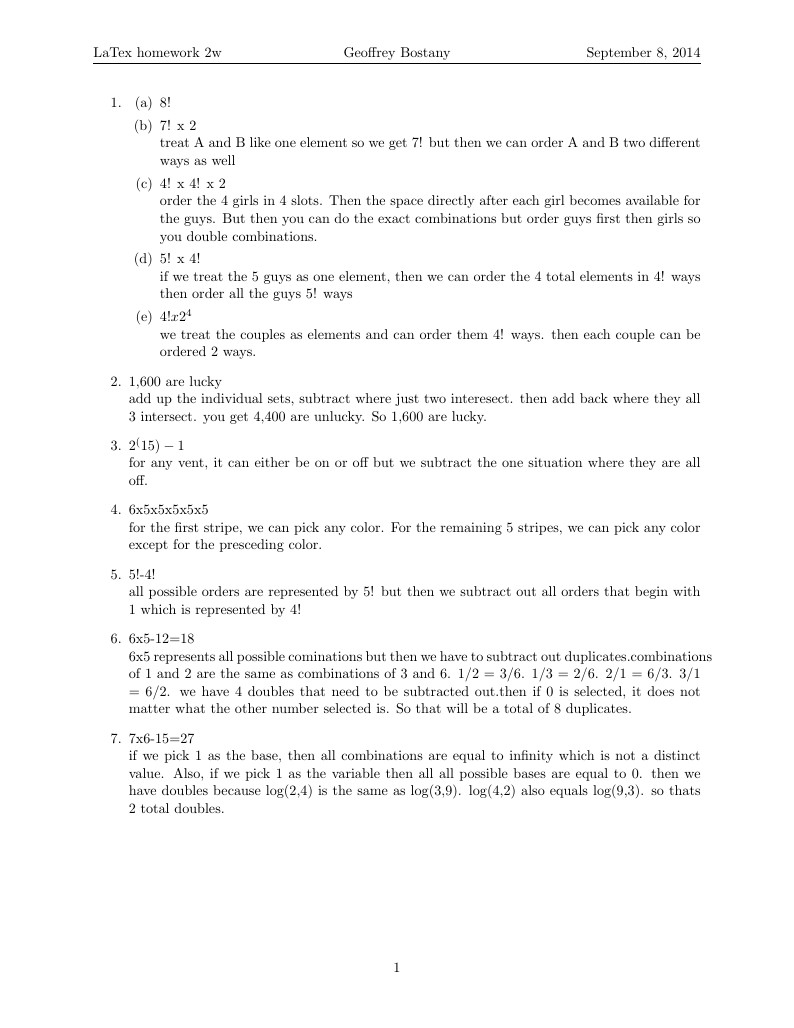
homework 2w
Auteur:
Geoffrey Bostany
Last Updated:
il y a 11 ans
License:
Creative Commons CC BY 4.0
Résumé:
homework

\begin
Discover why over 20 million people worldwide trust Overleaf with their work.

\begin
Discover why over 20 million people worldwide trust Overleaf with their work.
\documentclass[11pt]{article}
\usepackage[margin=1in]{geometry}
\usepackage{fancyhdr}
\pagestyle{fancy}
\usepackage{amsmath}
\usepackage{amssymb}
\lhead{LaTex\ homework 2w}
\chead{Geoffrey Bostany}
\rhead{September 8, 2014}
\begin{document}
\begin{enumerate}
\item
\begin{enumerate}
\item 8!
\item 7! x 2 \\treat A and B like one element so we get 7! but then we can order A and B two different ways as well
\item 4! x 4! x 2\\ order the 4 girls in 4 slots. Then the space directly after each girl becomes available for the guys. But then you can do the exact combinations but order guys first then girls so you double combinations.
\item 5! x 4!\\ if we treat the 5 guys as one element, then we can order the 4 total elements in 4! ways then order all the guys 5! ways
\item $4! x 2^4$ \\ we treat the couples as elements and can order them 4! ways. then each couple can be ordered 2 ways.
\end{enumerate}
\item 1,600 are lucky\\add up the individual sets, subtract where just two interesect. then add back where they all 3 intersect. you get 4,400 are unlucky. So 1,600 are lucky.
\item $2^(15)-1$\\ for any vent, it can either be on or off but we subtract the one situation where they are all off.
\item 6x5x5x5x5x5 \\ for the first stripe, we can pick any color. For the remaining 5 stripes, we can pick any color except for the presceding color.
\item 5!-4!\\all possible orders are represented by 5! but then we subtract out all orders that begin with 1 which is represented by 4!
\item 6x5-12=18\\ 6x5 represents all possible cominations but then we have to subtract out duplicates.combinations of 1 and 2 are the same as combinations of 3 and 6. 1/2 = 3/6. 1/3 = 2/6. 2/1 = 6/3. 3/1 = 6/2. we have 4 doubles that need to be subtracted out.then if 0 is selected, it does not matter what the other number selected is. So that will be a total of 8 duplicates.
\item 7x6-15=27\\if we pick 1 as the base, then all combinations are equal to infinity which is not a distinct value. Also, if we pick 1 as the variable then all all possible bases are equal to 0. then we have doubles because log(2,4) is the same as log(3,9). log(4,2) also equals log(9,3). so thats 2 total doubles.
\end{enumerate}
\end{document}